Validity in Questionnaire Design: A Master's Level Research Focus
VerifiedAdded on 2022/09/28
|9
|2270
|28
Essay
AI Summary
This essay explores the concept of validity in the context of designing research questionnaires at the master's level. It emphasizes the importance of validity in ensuring that a questionnaire accurately measures what it intends to measure. Different types of validity, including face validity, content validity, criterion-related validity, and construct validity, are discussed, along with techniques for testing the validity of research questionnaires. The essay highlights that validity is essential not only for master's level learners but also across all levels of education and various realms of research. It also provides references to support the information presented.
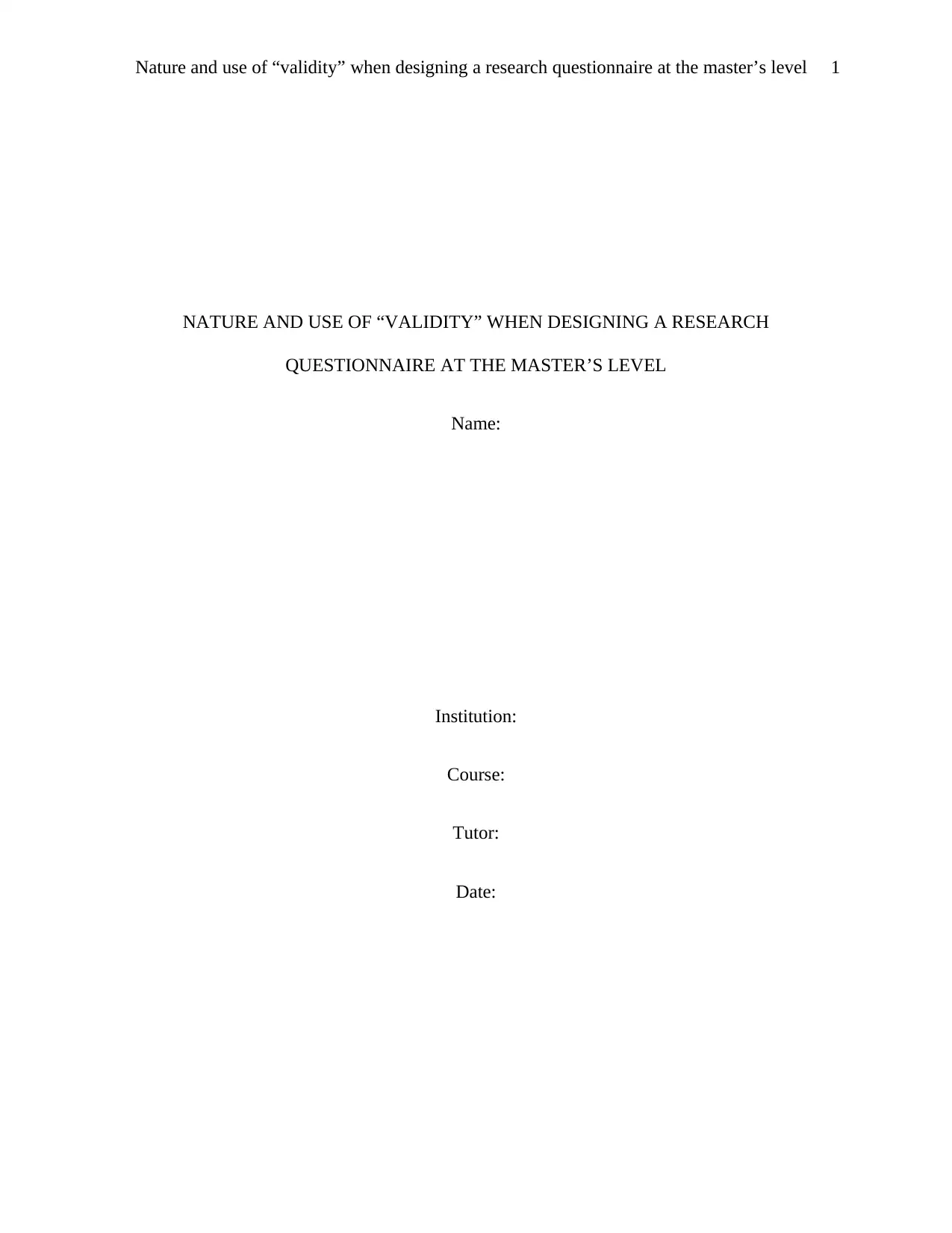
Nature and use of “validity” when designing a research questionnaire at the master’s level 1
NATURE AND USE OF “VALIDITY” WHEN DESIGNING A RESEARCH
QUESTIONNAIRE AT THE MASTER’S LEVEL
Name:
Institution:
Course:
Tutor:
Date:
NATURE AND USE OF “VALIDITY” WHEN DESIGNING A RESEARCH
QUESTIONNAIRE AT THE MASTER’S LEVEL
Name:
Institution:
Course:
Tutor:
Date:
Paraphrase This Document
Need a fresh take? Get an instant paraphrase of this document with our AI Paraphraser
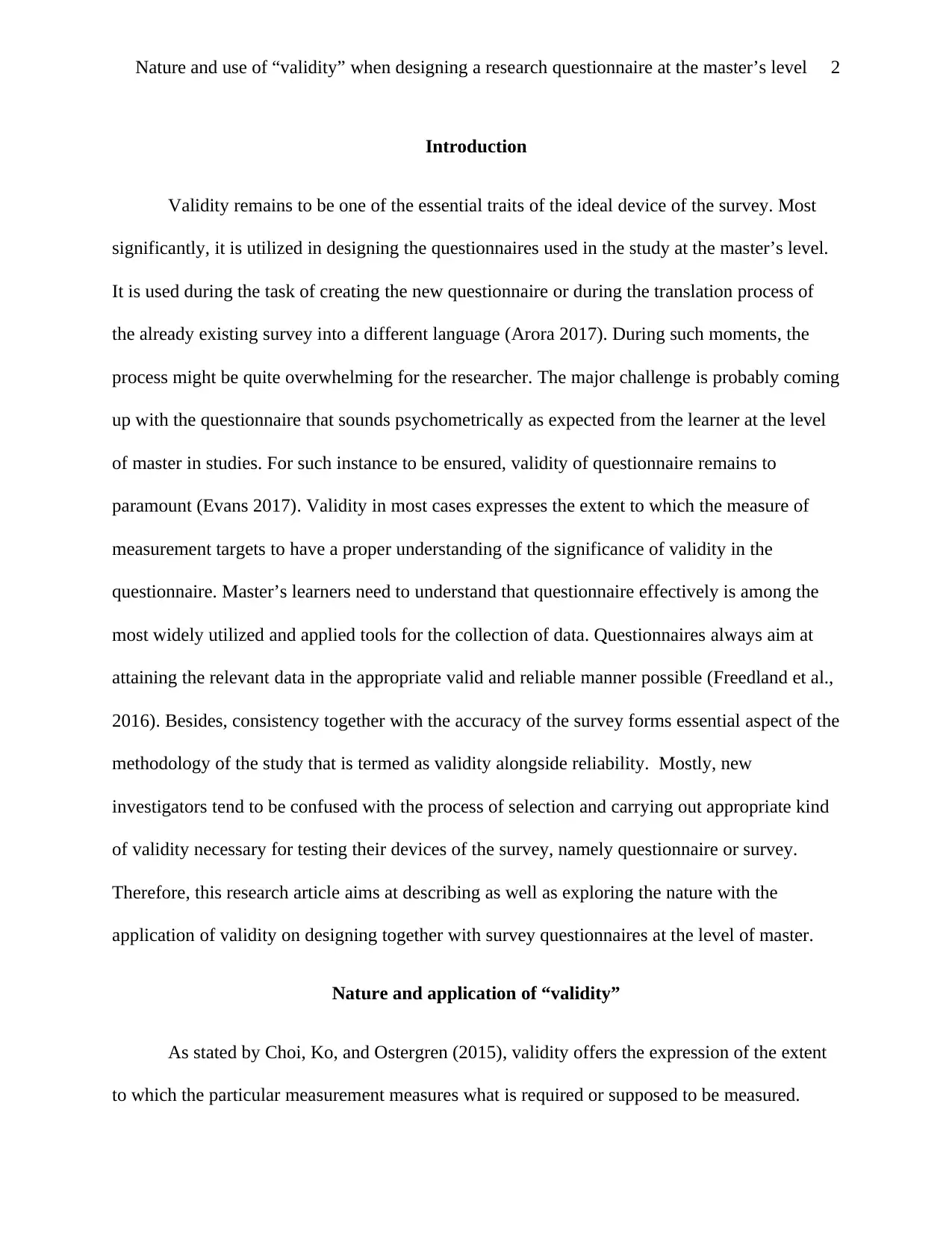
Nature and use of “validity” when designing a research questionnaire at the master’s level 2
Introduction
Validity remains to be one of the essential traits of the ideal device of the survey. Most
significantly, it is utilized in designing the questionnaires used in the study at the master’s level.
It is used during the task of creating the new questionnaire or during the translation process of
the already existing survey into a different language (Arora 2017). During such moments, the
process might be quite overwhelming for the researcher. The major challenge is probably coming
up with the questionnaire that sounds psychometrically as expected from the learner at the level
of master in studies. For such instance to be ensured, validity of questionnaire remains to
paramount (Evans 2017). Validity in most cases expresses the extent to which the measure of
measurement targets to have a proper understanding of the significance of validity in the
questionnaire. Master’s learners need to understand that questionnaire effectively is among the
most widely utilized and applied tools for the collection of data. Questionnaires always aim at
attaining the relevant data in the appropriate valid and reliable manner possible (Freedland et al.,
2016). Besides, consistency together with the accuracy of the survey forms essential aspect of the
methodology of the study that is termed as validity alongside reliability. Mostly, new
investigators tend to be confused with the process of selection and carrying out appropriate kind
of validity necessary for testing their devices of the survey, namely questionnaire or survey.
Therefore, this research article aims at describing as well as exploring the nature with the
application of validity on designing together with survey questionnaires at the level of master.
Nature and application of “validity”
As stated by Choi, Ko, and Ostergren (2015), validity offers the expression of the extent
to which the particular measurement measures what is required or supposed to be measured.
Introduction
Validity remains to be one of the essential traits of the ideal device of the survey. Most
significantly, it is utilized in designing the questionnaires used in the study at the master’s level.
It is used during the task of creating the new questionnaire or during the translation process of
the already existing survey into a different language (Arora 2017). During such moments, the
process might be quite overwhelming for the researcher. The major challenge is probably coming
up with the questionnaire that sounds psychometrically as expected from the learner at the level
of master in studies. For such instance to be ensured, validity of questionnaire remains to
paramount (Evans 2017). Validity in most cases expresses the extent to which the measure of
measurement targets to have a proper understanding of the significance of validity in the
questionnaire. Master’s learners need to understand that questionnaire effectively is among the
most widely utilized and applied tools for the collection of data. Questionnaires always aim at
attaining the relevant data in the appropriate valid and reliable manner possible (Freedland et al.,
2016). Besides, consistency together with the accuracy of the survey forms essential aspect of the
methodology of the study that is termed as validity alongside reliability. Mostly, new
investigators tend to be confused with the process of selection and carrying out appropriate kind
of validity necessary for testing their devices of the survey, namely questionnaire or survey.
Therefore, this research article aims at describing as well as exploring the nature with the
application of validity on designing together with survey questionnaires at the level of master.
Nature and application of “validity”
As stated by Choi, Ko, and Ostergren (2015), validity offers the expression of the extent
to which the particular measurement measures what is required or supposed to be measured.
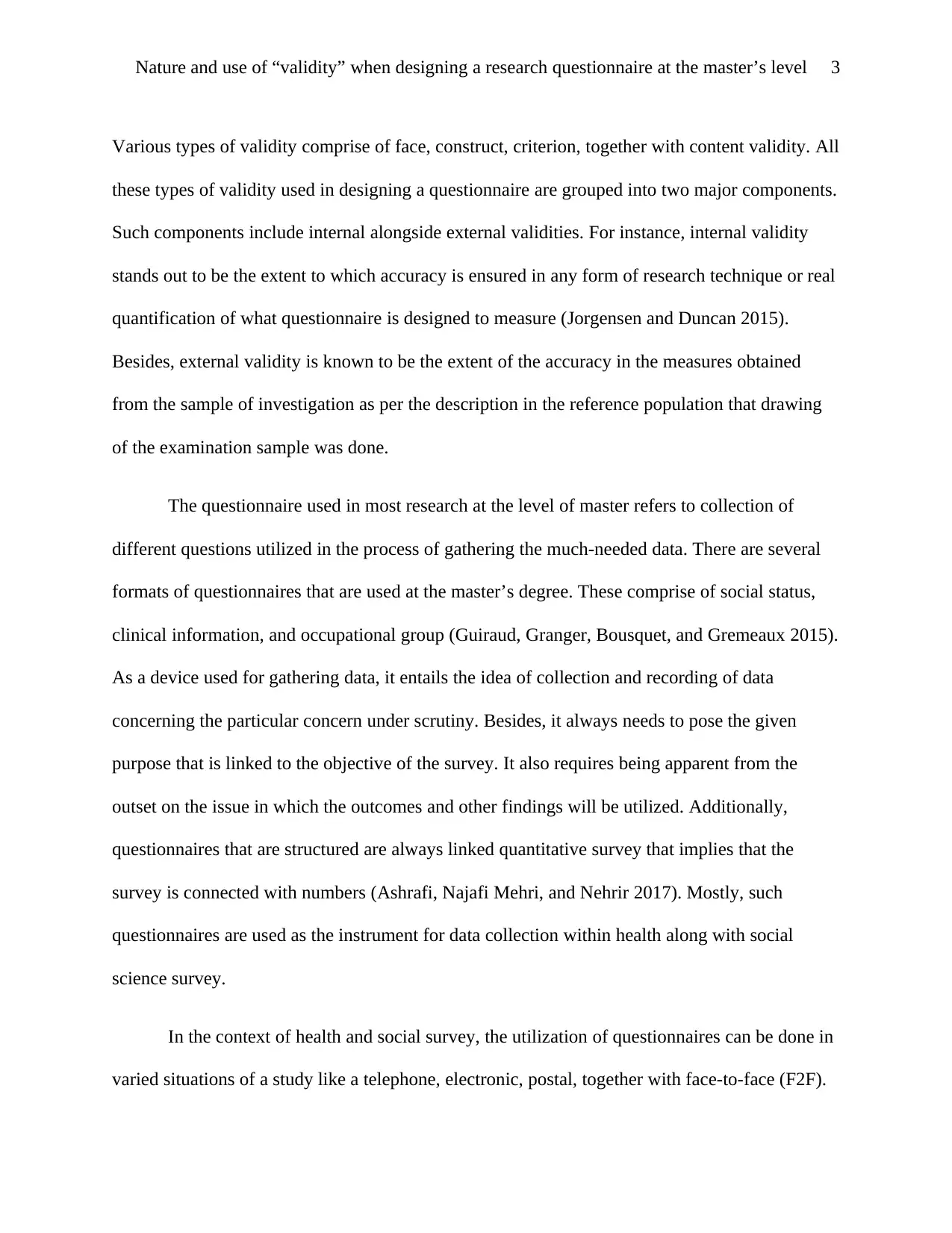
Nature and use of “validity” when designing a research questionnaire at the master’s level 3
Various types of validity comprise of face, construct, criterion, together with content validity. All
these types of validity used in designing a questionnaire are grouped into two major components.
Such components include internal alongside external validities. For instance, internal validity
stands out to be the extent to which accuracy is ensured in any form of research technique or real
quantification of what questionnaire is designed to measure (Jorgensen and Duncan 2015).
Besides, external validity is known to be the extent of the accuracy in the measures obtained
from the sample of investigation as per the description in the reference population that drawing
of the examination sample was done.
The questionnaire used in most research at the level of master refers to collection of
different questions utilized in the process of gathering the much-needed data. There are several
formats of questionnaires that are used at the master’s degree. These comprise of social status,
clinical information, and occupational group (Guiraud, Granger, Bousquet, and Gremeaux 2015).
As a device used for gathering data, it entails the idea of collection and recording of data
concerning the particular concern under scrutiny. Besides, it always needs to pose the given
purpose that is linked to the objective of the survey. It also requires being apparent from the
outset on the issue in which the outcomes and other findings will be utilized. Additionally,
questionnaires that are structured are always linked quantitative survey that implies that the
survey is connected with numbers (Ashrafi, Najafi Mehri, and Nehrir 2017). Mostly, such
questionnaires are used as the instrument for data collection within health along with social
science survey.
In the context of health and social survey, the utilization of questionnaires can be done in
varied situations of a study like a telephone, electronic, postal, together with face-to-face (F2F).
Various types of validity comprise of face, construct, criterion, together with content validity. All
these types of validity used in designing a questionnaire are grouped into two major components.
Such components include internal alongside external validities. For instance, internal validity
stands out to be the extent to which accuracy is ensured in any form of research technique or real
quantification of what questionnaire is designed to measure (Jorgensen and Duncan 2015).
Besides, external validity is known to be the extent of the accuracy in the measures obtained
from the sample of investigation as per the description in the reference population that drawing
of the examination sample was done.
The questionnaire used in most research at the level of master refers to collection of
different questions utilized in the process of gathering the much-needed data. There are several
formats of questionnaires that are used at the master’s degree. These comprise of social status,
clinical information, and occupational group (Guiraud, Granger, Bousquet, and Gremeaux 2015).
As a device used for gathering data, it entails the idea of collection and recording of data
concerning the particular concern under scrutiny. Besides, it always needs to pose the given
purpose that is linked to the objective of the survey. It also requires being apparent from the
outset on the issue in which the outcomes and other findings will be utilized. Additionally,
questionnaires that are structured are always linked quantitative survey that implies that the
survey is connected with numbers (Ashrafi, Najafi Mehri, and Nehrir 2017). Mostly, such
questionnaires are used as the instrument for data collection within health along with social
science survey.
In the context of health and social survey, the utilization of questionnaires can be done in
varied situations of a study like a telephone, electronic, postal, together with face-to-face (F2F).
⊘ This is a preview!⊘
Do you want full access?
Subscribe today to unlock all pages.

Trusted by 1+ million students worldwide
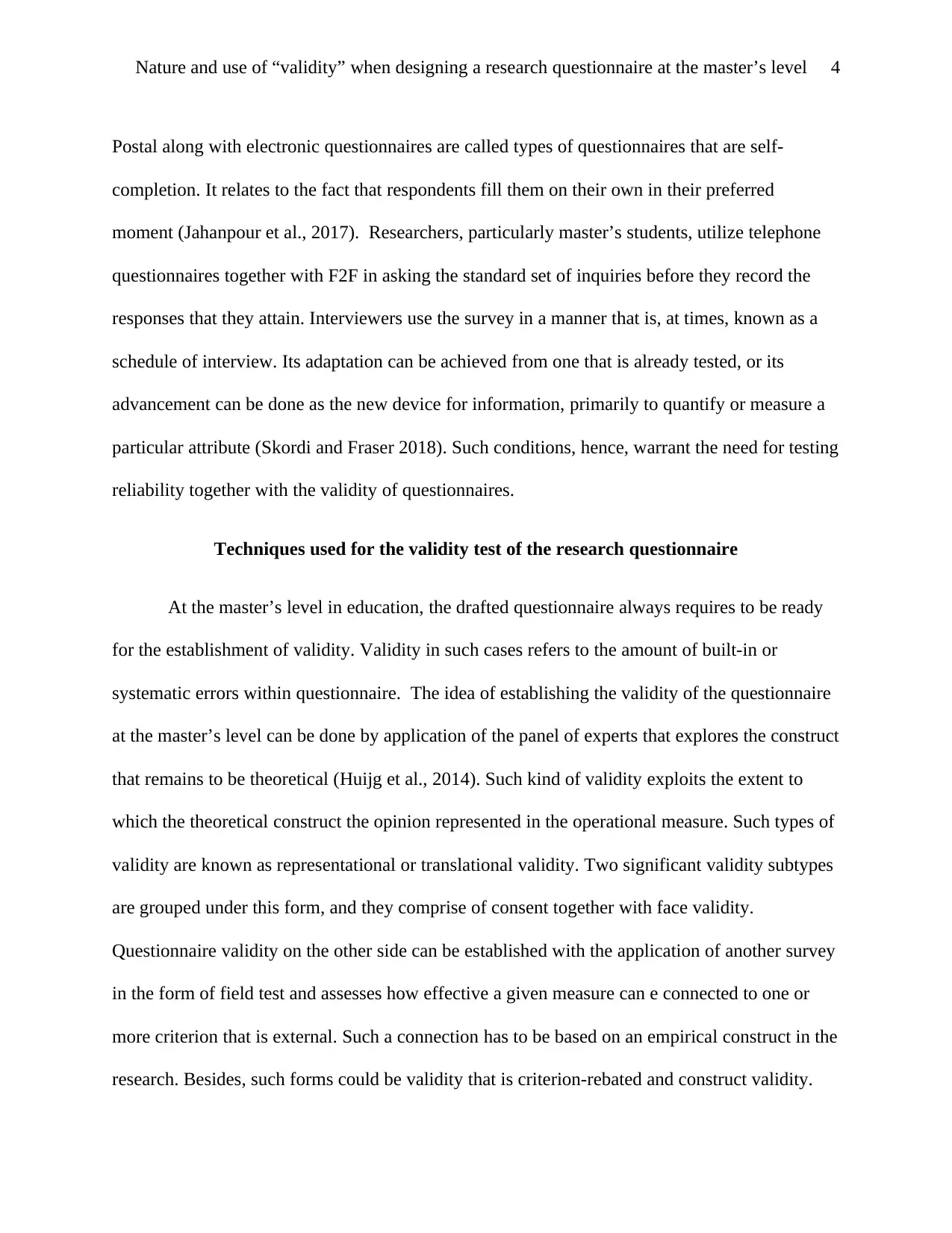
Nature and use of “validity” when designing a research questionnaire at the master’s level 4
Postal along with electronic questionnaires are called types of questionnaires that are self-
completion. It relates to the fact that respondents fill them on their own in their preferred
moment (Jahanpour et al., 2017). Researchers, particularly master’s students, utilize telephone
questionnaires together with F2F in asking the standard set of inquiries before they record the
responses that they attain. Interviewers use the survey in a manner that is, at times, known as a
schedule of interview. Its adaptation can be achieved from one that is already tested, or its
advancement can be done as the new device for information, primarily to quantify or measure a
particular attribute (Skordi and Fraser 2018). Such conditions, hence, warrant the need for testing
reliability together with the validity of questionnaires.
Techniques used for the validity test of the research questionnaire
At the master’s level in education, the drafted questionnaire always requires to be ready
for the establishment of validity. Validity in such cases refers to the amount of built-in or
systematic errors within questionnaire. The idea of establishing the validity of the questionnaire
at the master’s level can be done by application of the panel of experts that explores the construct
that remains to be theoretical (Huijg et al., 2014). Such kind of validity exploits the extent to
which the theoretical construct the opinion represented in the operational measure. Such types of
validity are known as representational or translational validity. Two significant validity subtypes
are grouped under this form, and they comprise of consent together with face validity.
Questionnaire validity on the other side can be established with the application of another survey
in the form of field test and assesses how effective a given measure can e connected to one or
more criterion that is external. Such a connection has to be based on an empirical construct in the
research. Besides, such forms could be validity that is criterion-rebated and construct validity.
Postal along with electronic questionnaires are called types of questionnaires that are self-
completion. It relates to the fact that respondents fill them on their own in their preferred
moment (Jahanpour et al., 2017). Researchers, particularly master’s students, utilize telephone
questionnaires together with F2F in asking the standard set of inquiries before they record the
responses that they attain. Interviewers use the survey in a manner that is, at times, known as a
schedule of interview. Its adaptation can be achieved from one that is already tested, or its
advancement can be done as the new device for information, primarily to quantify or measure a
particular attribute (Skordi and Fraser 2018). Such conditions, hence, warrant the need for testing
reliability together with the validity of questionnaires.
Techniques used for the validity test of the research questionnaire
At the master’s level in education, the drafted questionnaire always requires to be ready
for the establishment of validity. Validity in such cases refers to the amount of built-in or
systematic errors within questionnaire. The idea of establishing the validity of the questionnaire
at the master’s level can be done by application of the panel of experts that explores the construct
that remains to be theoretical (Huijg et al., 2014). Such kind of validity exploits the extent to
which the theoretical construct the opinion represented in the operational measure. Such types of
validity are known as representational or translational validity. Two significant validity subtypes
are grouped under this form, and they comprise of consent together with face validity.
Questionnaire validity on the other side can be established with the application of another survey
in the form of field test and assesses how effective a given measure can e connected to one or
more criterion that is external. Such a connection has to be based on an empirical construct in the
research. Besides, such forms could be validity that is criterion-rebated and construct validity.
Paraphrase This Document
Need a fresh take? Get an instant paraphrase of this document with our AI Paraphraser
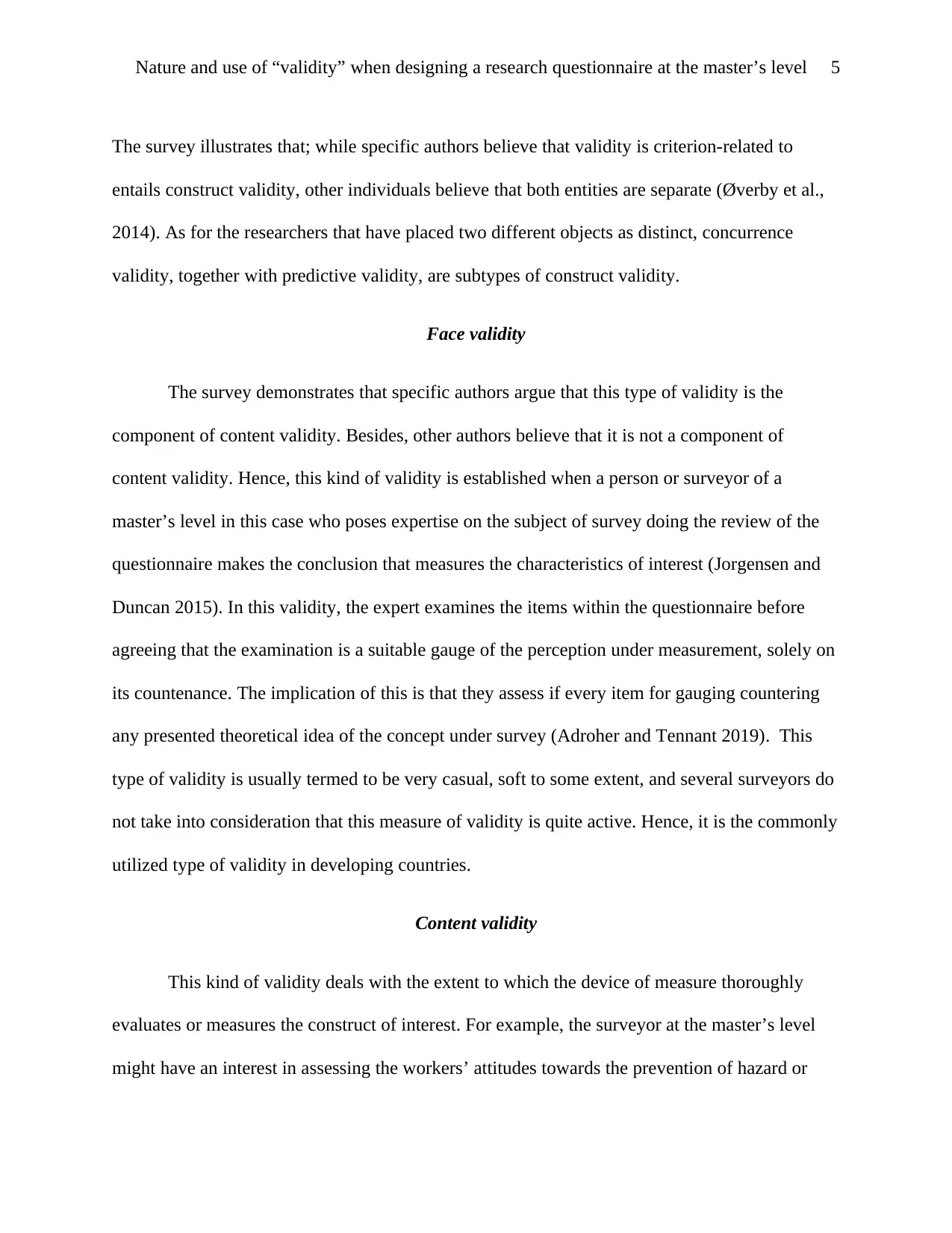
Nature and use of “validity” when designing a research questionnaire at the master’s level 5
The survey illustrates that; while specific authors believe that validity is criterion-related to
entails construct validity, other individuals believe that both entities are separate (Øverby et al.,
2014). As for the researchers that have placed two different objects as distinct, concurrence
validity, together with predictive validity, are subtypes of construct validity.
Face validity
The survey demonstrates that specific authors argue that this type of validity is the
component of content validity. Besides, other authors believe that it is not a component of
content validity. Hence, this kind of validity is established when a person or surveyor of a
master’s level in this case who poses expertise on the subject of survey doing the review of the
questionnaire makes the conclusion that measures the characteristics of interest (Jorgensen and
Duncan 2015). In this validity, the expert examines the items within the questionnaire before
agreeing that the examination is a suitable gauge of the perception under measurement, solely on
its countenance. The implication of this is that they assess if every item for gauging countering
any presented theoretical idea of the concept under survey (Adroher and Tennant 2019). This
type of validity is usually termed to be very casual, soft to some extent, and several surveyors do
not take into consideration that this measure of validity is quite active. Hence, it is the commonly
utilized type of validity in developing countries.
Content validity
This kind of validity deals with the extent to which the device of measure thoroughly
evaluates or measures the construct of interest. For example, the surveyor at the master’s level
might have an interest in assessing the workers’ attitudes towards the prevention of hazard or
The survey illustrates that; while specific authors believe that validity is criterion-related to
entails construct validity, other individuals believe that both entities are separate (Øverby et al.,
2014). As for the researchers that have placed two different objects as distinct, concurrence
validity, together with predictive validity, are subtypes of construct validity.
Face validity
The survey demonstrates that specific authors argue that this type of validity is the
component of content validity. Besides, other authors believe that it is not a component of
content validity. Hence, this kind of validity is established when a person or surveyor of a
master’s level in this case who poses expertise on the subject of survey doing the review of the
questionnaire makes the conclusion that measures the characteristics of interest (Jorgensen and
Duncan 2015). In this validity, the expert examines the items within the questionnaire before
agreeing that the examination is a suitable gauge of the perception under measurement, solely on
its countenance. The implication of this is that they assess if every item for gauging countering
any presented theoretical idea of the concept under survey (Adroher and Tennant 2019). This
type of validity is usually termed to be very casual, soft to some extent, and several surveyors do
not take into consideration that this measure of validity is quite active. Hence, it is the commonly
utilized type of validity in developing countries.
Content validity
This kind of validity deals with the extent to which the device of measure thoroughly
evaluates or measures the construct of interest. For example, the surveyor at the master’s level
might have an interest in assessing the workers’ attitudes towards the prevention of hazard or
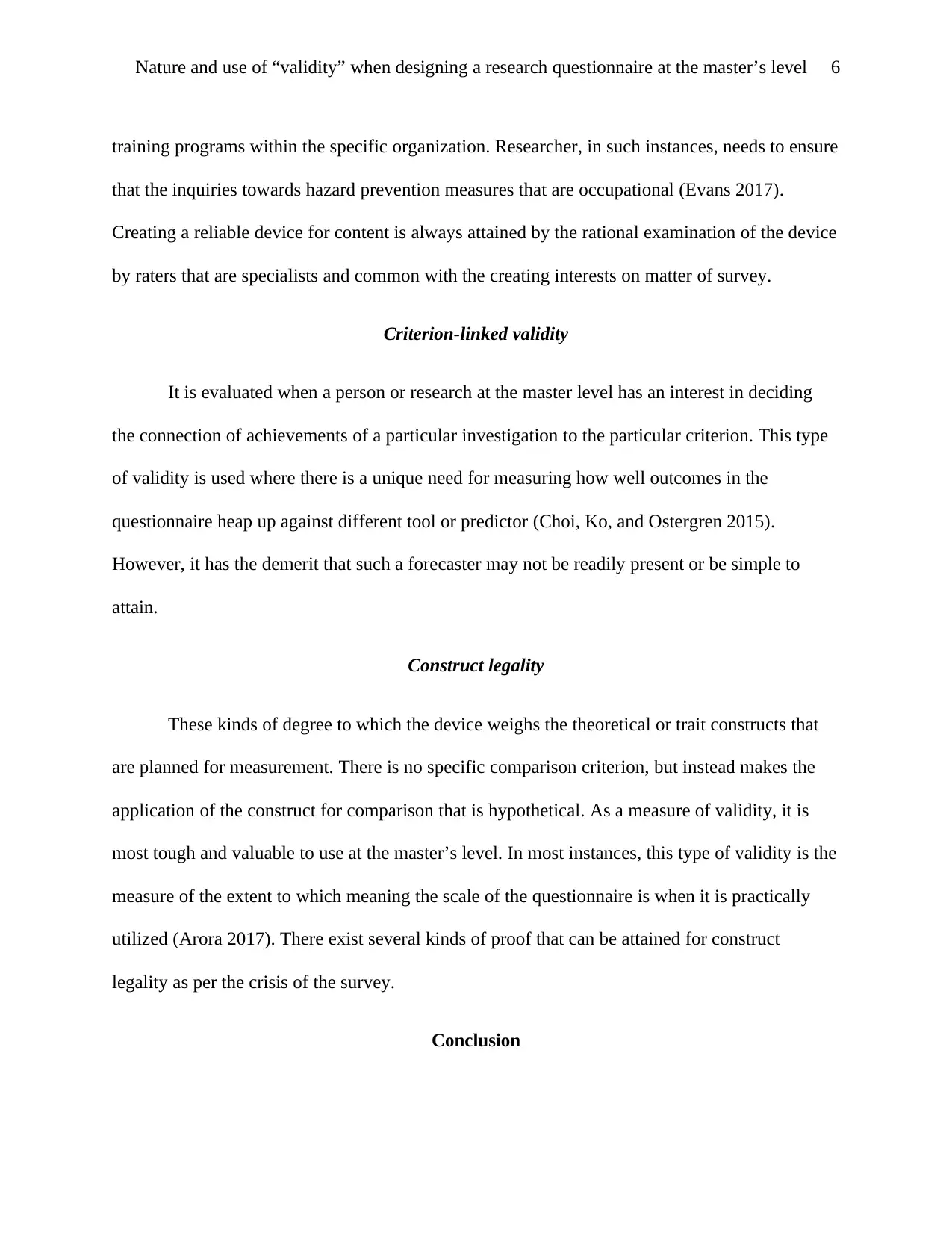
Nature and use of “validity” when designing a research questionnaire at the master’s level 6
training programs within the specific organization. Researcher, in such instances, needs to ensure
that the inquiries towards hazard prevention measures that are occupational (Evans 2017).
Creating a reliable device for content is always attained by the rational examination of the device
by raters that are specialists and common with the creating interests on matter of survey.
Criterion-linked validity
It is evaluated when a person or research at the master level has an interest in deciding
the connection of achievements of a particular investigation to the particular criterion. This type
of validity is used where there is a unique need for measuring how well outcomes in the
questionnaire heap up against different tool or predictor (Choi, Ko, and Ostergren 2015).
However, it has the demerit that such a forecaster may not be readily present or be simple to
attain.
Construct legality
These kinds of degree to which the device weighs the theoretical or trait constructs that
are planned for measurement. There is no specific comparison criterion, but instead makes the
application of the construct for comparison that is hypothetical. As a measure of validity, it is
most tough and valuable to use at the master’s level. In most instances, this type of validity is the
measure of the extent to which meaning the scale of the questionnaire is when it is practically
utilized (Arora 2017). There exist several kinds of proof that can be attained for construct
legality as per the crisis of the survey.
Conclusion
training programs within the specific organization. Researcher, in such instances, needs to ensure
that the inquiries towards hazard prevention measures that are occupational (Evans 2017).
Creating a reliable device for content is always attained by the rational examination of the device
by raters that are specialists and common with the creating interests on matter of survey.
Criterion-linked validity
It is evaluated when a person or research at the master level has an interest in deciding
the connection of achievements of a particular investigation to the particular criterion. This type
of validity is used where there is a unique need for measuring how well outcomes in the
questionnaire heap up against different tool or predictor (Choi, Ko, and Ostergren 2015).
However, it has the demerit that such a forecaster may not be readily present or be simple to
attain.
Construct legality
These kinds of degree to which the device weighs the theoretical or trait constructs that
are planned for measurement. There is no specific comparison criterion, but instead makes the
application of the construct for comparison that is hypothetical. As a measure of validity, it is
most tough and valuable to use at the master’s level. In most instances, this type of validity is the
measure of the extent to which meaning the scale of the questionnaire is when it is practically
utilized (Arora 2017). There exist several kinds of proof that can be attained for construct
legality as per the crisis of the survey.
Conclusion
⊘ This is a preview!⊘
Do you want full access?
Subscribe today to unlock all pages.

Trusted by 1+ million students worldwide
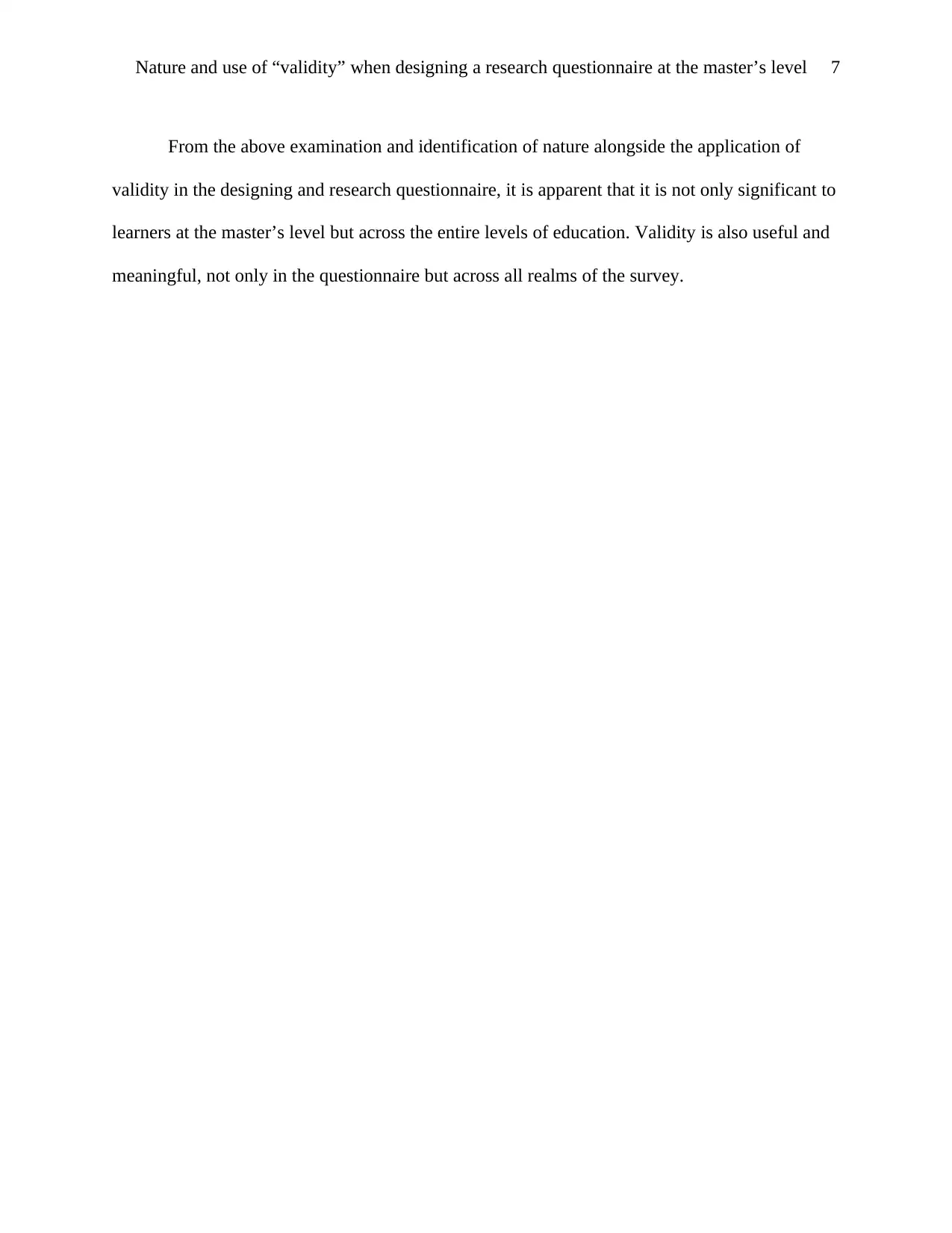
Nature and use of “validity” when designing a research questionnaire at the master’s level 7
From the above examination and identification of nature alongside the application of
validity in the designing and research questionnaire, it is apparent that it is not only significant to
learners at the master’s level but across the entire levels of education. Validity is also useful and
meaningful, not only in the questionnaire but across all realms of the survey.
From the above examination and identification of nature alongside the application of
validity in the designing and research questionnaire, it is apparent that it is not only significant to
learners at the master’s level but across the entire levels of education. Validity is also useful and
meaningful, not only in the questionnaire but across all realms of the survey.
Paraphrase This Document
Need a fresh take? Get an instant paraphrase of this document with our AI Paraphraser
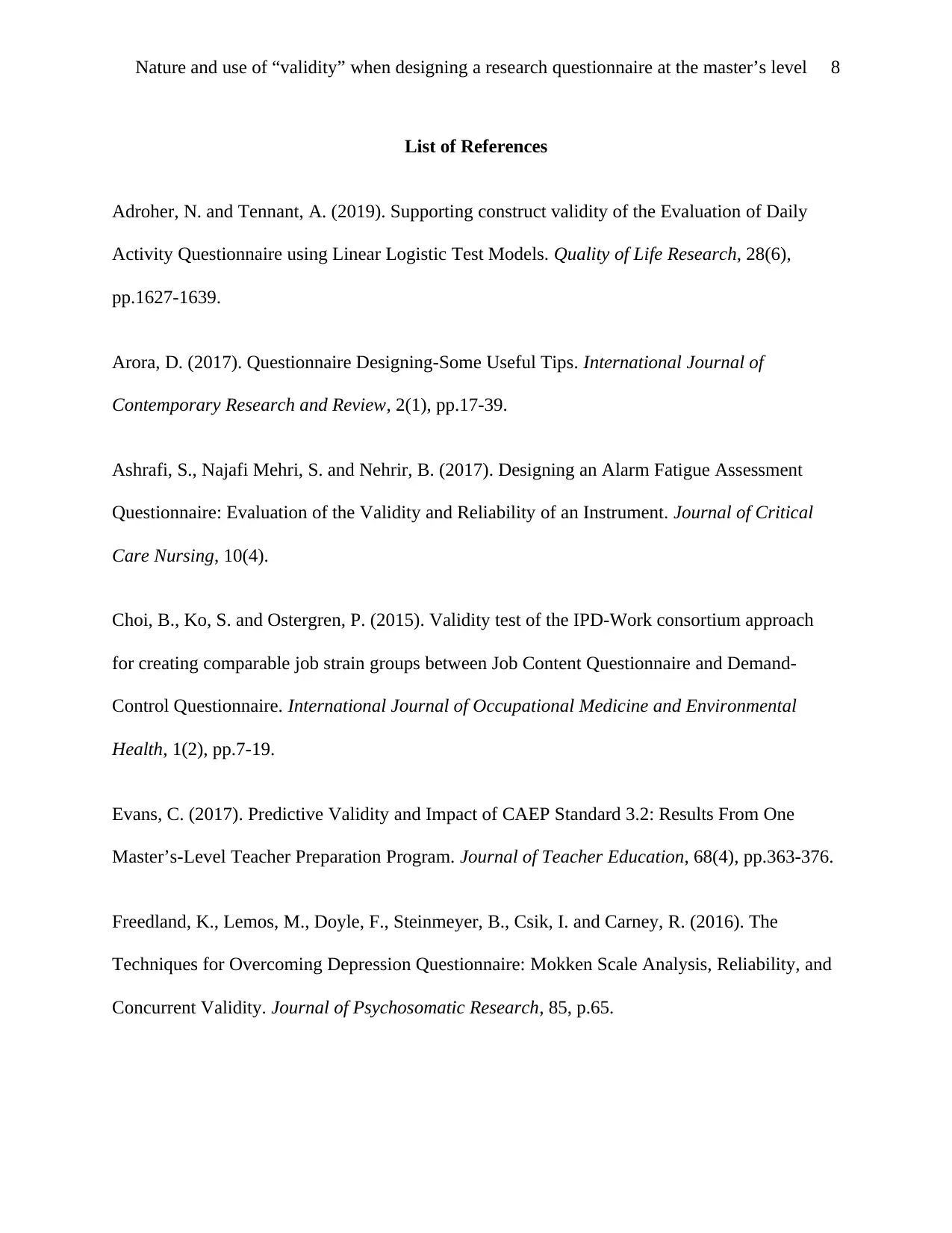
Nature and use of “validity” when designing a research questionnaire at the master’s level 8
List of References
Adroher, N. and Tennant, A. (2019). Supporting construct validity of the Evaluation of Daily
Activity Questionnaire using Linear Logistic Test Models. Quality of Life Research, 28(6),
pp.1627-1639.
Arora, D. (2017). Questionnaire Designing-Some Useful Tips. International Journal of
Contemporary Research and Review, 2(1), pp.17-39.
Ashrafi, S., Najafi Mehri, S. and Nehrir, B. (2017). Designing an Alarm Fatigue Assessment
Questionnaire: Evaluation of the Validity and Reliability of an Instrument. Journal of Critical
Care Nursing, 10(4).
Choi, B., Ko, S. and Ostergren, P. (2015). Validity test of the IPD-Work consortium approach
for creating comparable job strain groups between Job Content Questionnaire and Demand-
Control Questionnaire. International Journal of Occupational Medicine and Environmental
Health, 1(2), pp.7-19.
Evans, C. (2017). Predictive Validity and Impact of CAEP Standard 3.2: Results From One
Master’s-Level Teacher Preparation Program. Journal of Teacher Education, 68(4), pp.363-376.
Freedland, K., Lemos, M., Doyle, F., Steinmeyer, B., Csik, I. and Carney, R. (2016). The
Techniques for Overcoming Depression Questionnaire: Mokken Scale Analysis, Reliability, and
Concurrent Validity. Journal of Psychosomatic Research, 85, p.65.
List of References
Adroher, N. and Tennant, A. (2019). Supporting construct validity of the Evaluation of Daily
Activity Questionnaire using Linear Logistic Test Models. Quality of Life Research, 28(6),
pp.1627-1639.
Arora, D. (2017). Questionnaire Designing-Some Useful Tips. International Journal of
Contemporary Research and Review, 2(1), pp.17-39.
Ashrafi, S., Najafi Mehri, S. and Nehrir, B. (2017). Designing an Alarm Fatigue Assessment
Questionnaire: Evaluation of the Validity and Reliability of an Instrument. Journal of Critical
Care Nursing, 10(4).
Choi, B., Ko, S. and Ostergren, P. (2015). Validity test of the IPD-Work consortium approach
for creating comparable job strain groups between Job Content Questionnaire and Demand-
Control Questionnaire. International Journal of Occupational Medicine and Environmental
Health, 1(2), pp.7-19.
Evans, C. (2017). Predictive Validity and Impact of CAEP Standard 3.2: Results From One
Master’s-Level Teacher Preparation Program. Journal of Teacher Education, 68(4), pp.363-376.
Freedland, K., Lemos, M., Doyle, F., Steinmeyer, B., Csik, I. and Carney, R. (2016). The
Techniques for Overcoming Depression Questionnaire: Mokken Scale Analysis, Reliability, and
Concurrent Validity. Journal of Psychosomatic Research, 85, p.65.
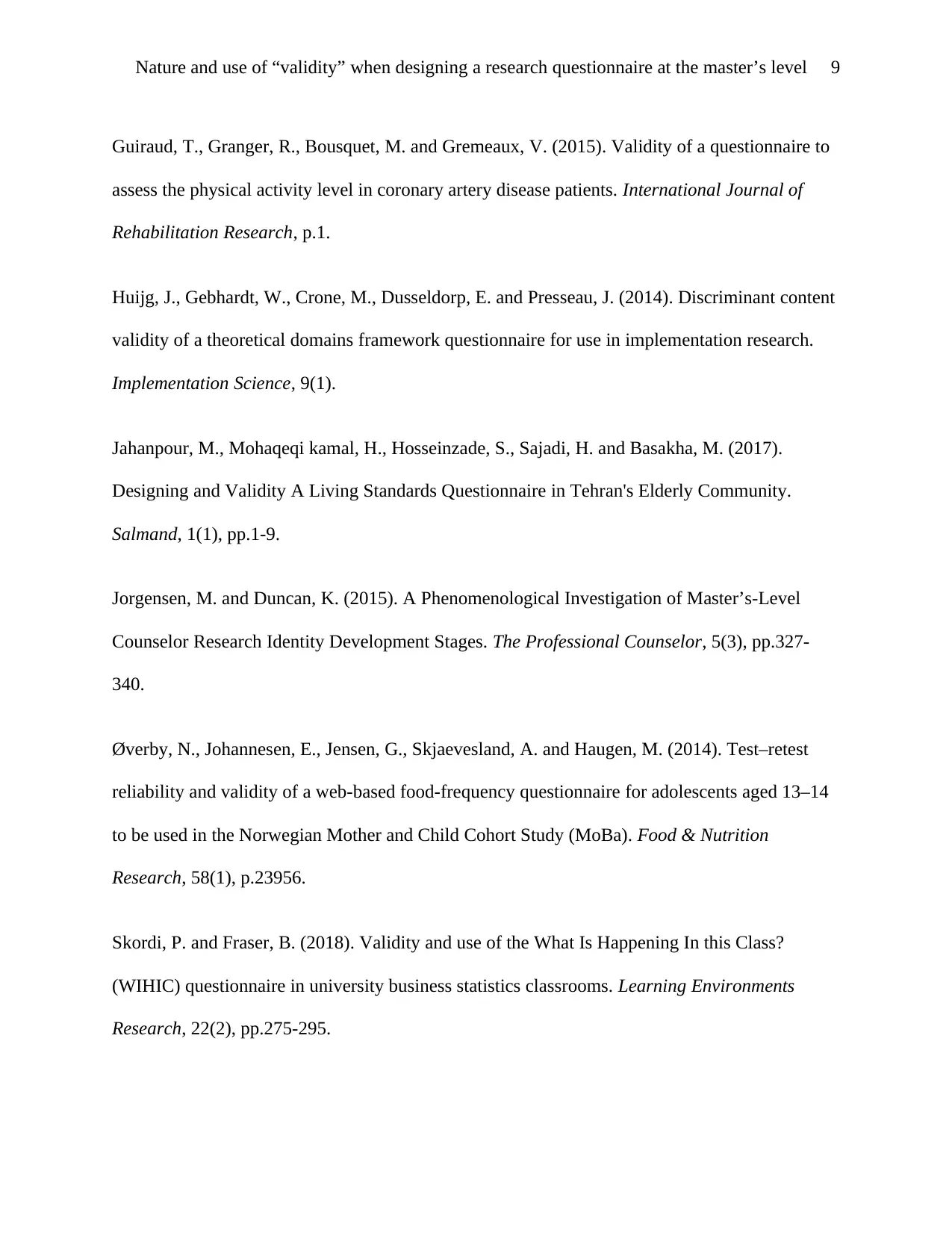
Nature and use of “validity” when designing a research questionnaire at the master’s level 9
Guiraud, T., Granger, R., Bousquet, M. and Gremeaux, V. (2015). Validity of a questionnaire to
assess the physical activity level in coronary artery disease patients. International Journal of
Rehabilitation Research, p.1.
Huijg, J., Gebhardt, W., Crone, M., Dusseldorp, E. and Presseau, J. (2014). Discriminant content
validity of a theoretical domains framework questionnaire for use in implementation research.
Implementation Science, 9(1).
Jahanpour, M., Mohaqeqi kamal, H., Hosseinzade, S., Sajadi, H. and Basakha, M. (2017).
Designing and Validity A Living Standards Questionnaire in Tehran's Elderly Community.
Salmand, 1(1), pp.1-9.
Jorgensen, M. and Duncan, K. (2015). A Phenomenological Investigation of Master’s-Level
Counselor Research Identity Development Stages. The Professional Counselor, 5(3), pp.327-
340.
Øverby, N., Johannesen, E., Jensen, G., Skjaevesland, A. and Haugen, M. (2014). Test–retest
reliability and validity of a web-based food-frequency questionnaire for adolescents aged 13–14
to be used in the Norwegian Mother and Child Cohort Study (MoBa). Food & Nutrition
Research, 58(1), p.23956.
Skordi, P. and Fraser, B. (2018). Validity and use of the What Is Happening In this Class?
(WIHIC) questionnaire in university business statistics classrooms. Learning Environments
Research, 22(2), pp.275-295.
Guiraud, T., Granger, R., Bousquet, M. and Gremeaux, V. (2015). Validity of a questionnaire to
assess the physical activity level in coronary artery disease patients. International Journal of
Rehabilitation Research, p.1.
Huijg, J., Gebhardt, W., Crone, M., Dusseldorp, E. and Presseau, J. (2014). Discriminant content
validity of a theoretical domains framework questionnaire for use in implementation research.
Implementation Science, 9(1).
Jahanpour, M., Mohaqeqi kamal, H., Hosseinzade, S., Sajadi, H. and Basakha, M. (2017).
Designing and Validity A Living Standards Questionnaire in Tehran's Elderly Community.
Salmand, 1(1), pp.1-9.
Jorgensen, M. and Duncan, K. (2015). A Phenomenological Investigation of Master’s-Level
Counselor Research Identity Development Stages. The Professional Counselor, 5(3), pp.327-
340.
Øverby, N., Johannesen, E., Jensen, G., Skjaevesland, A. and Haugen, M. (2014). Test–retest
reliability and validity of a web-based food-frequency questionnaire for adolescents aged 13–14
to be used in the Norwegian Mother and Child Cohort Study (MoBa). Food & Nutrition
Research, 58(1), p.23956.
Skordi, P. and Fraser, B. (2018). Validity and use of the What Is Happening In this Class?
(WIHIC) questionnaire in university business statistics classrooms. Learning Environments
Research, 22(2), pp.275-295.
⊘ This is a preview!⊘
Do you want full access?
Subscribe today to unlock all pages.

Trusted by 1+ million students worldwide
1 out of 9
Related Documents
Your All-in-One AI-Powered Toolkit for Academic Success.
+13062052269
info@desklib.com
Available 24*7 on WhatsApp / Email
![[object Object]](/_next/static/media/star-bottom.7253800d.svg)
Unlock your academic potential
Copyright © 2020–2025 A2Z Services. All Rights Reserved. Developed and managed by ZUCOL.





